- Home
- TV History
- Network Studios History
- Cameras
- Archives
- Viewseum
- About / Comments
Skip to content
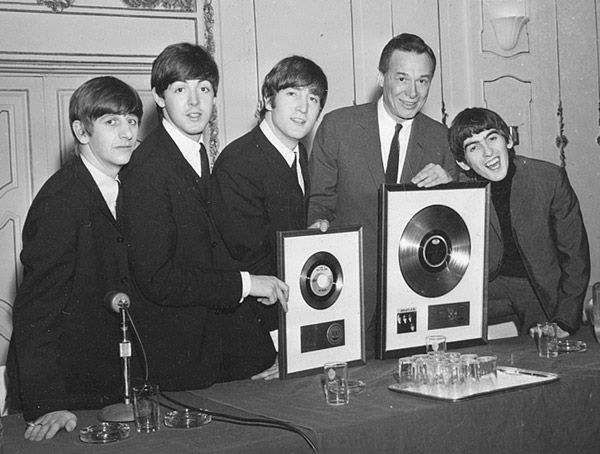



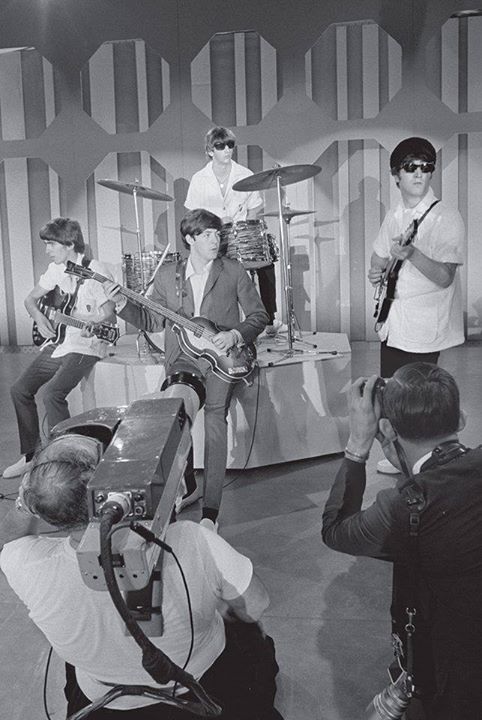

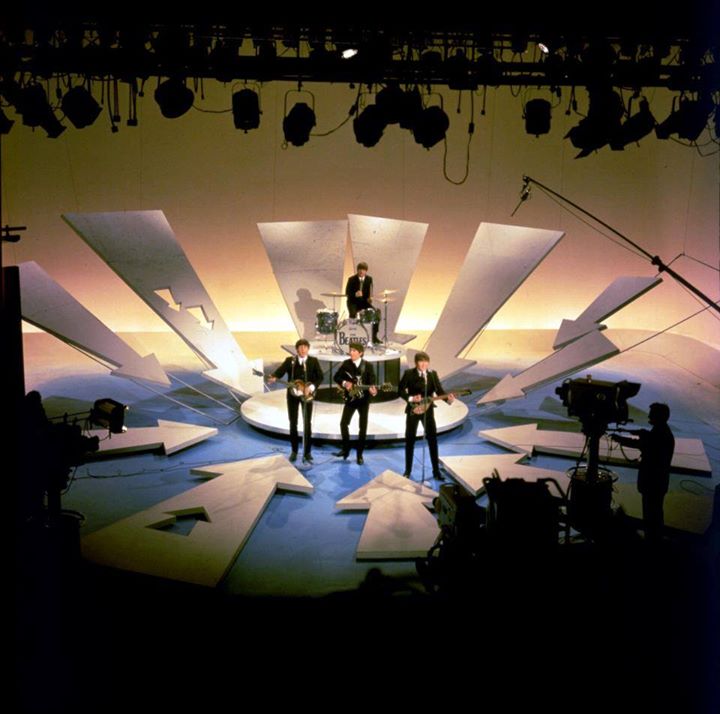

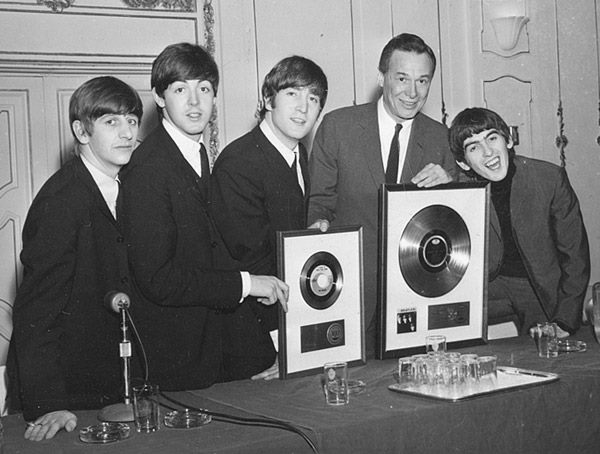





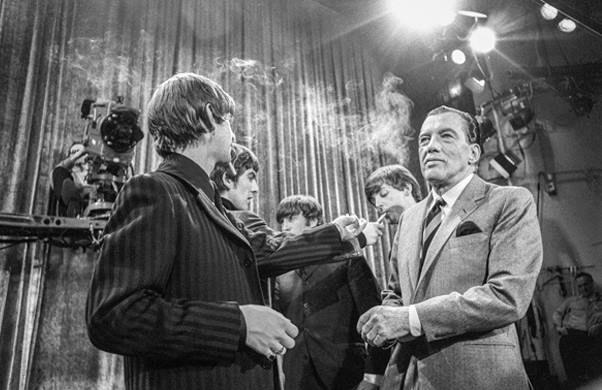

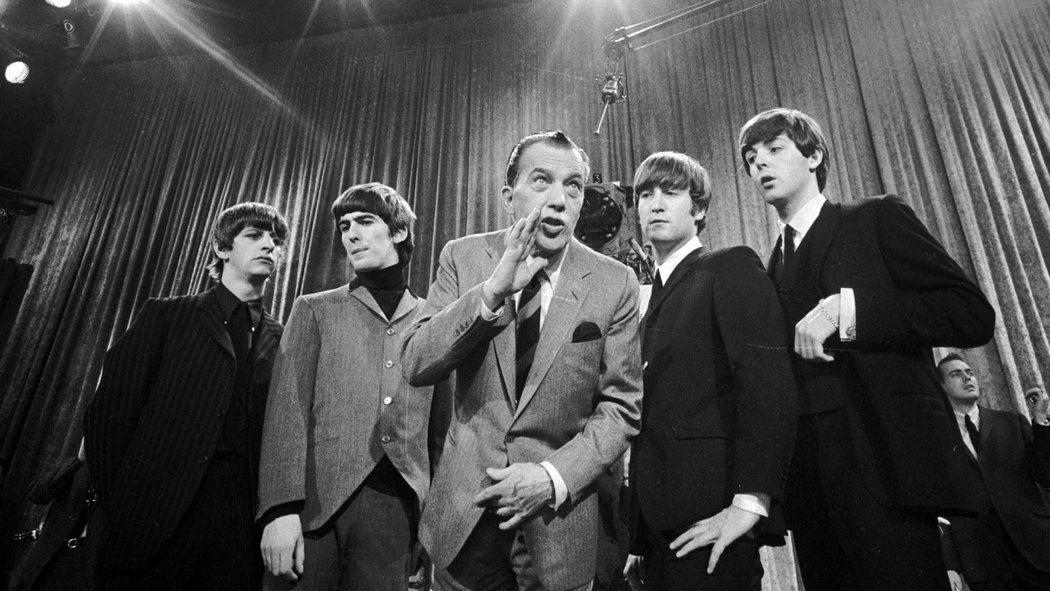

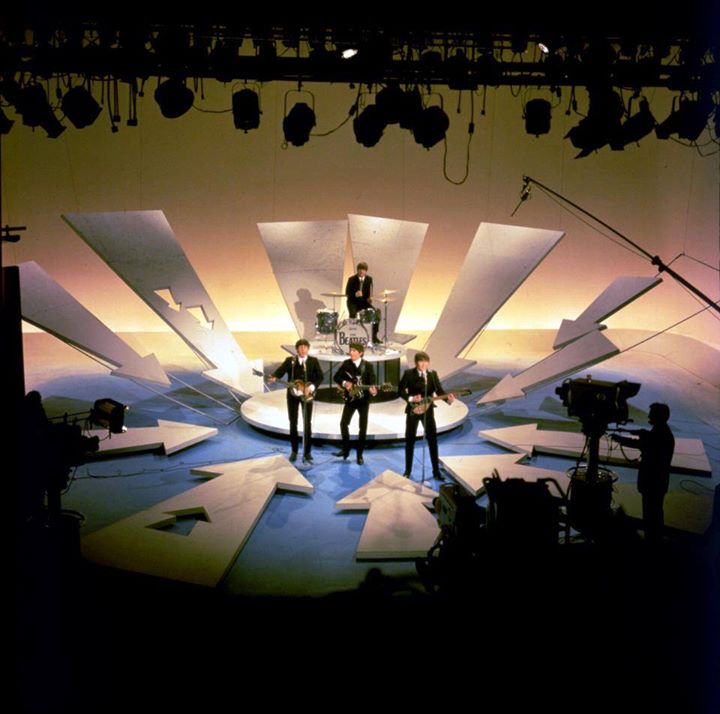



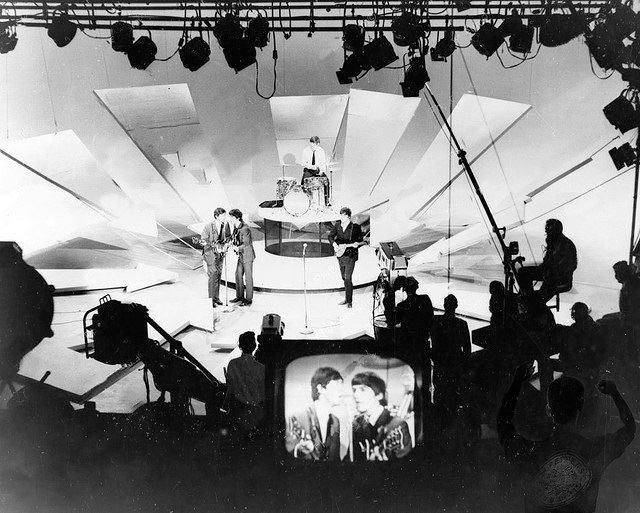



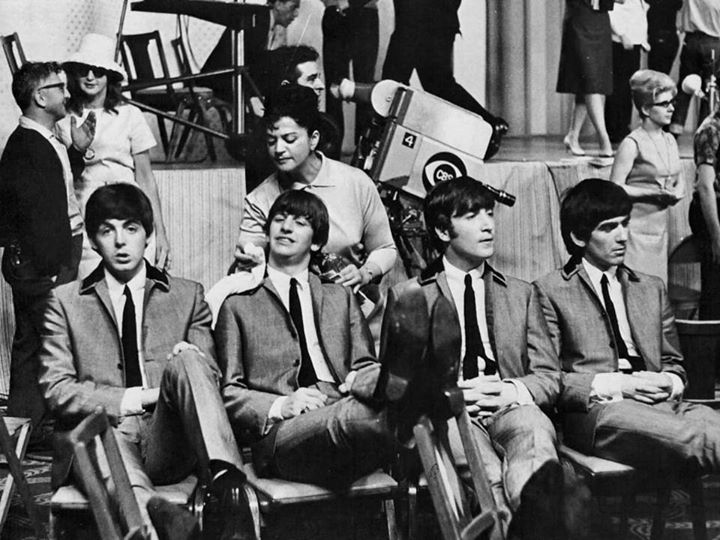

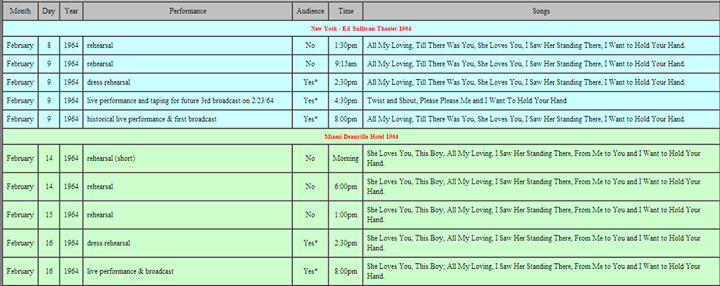



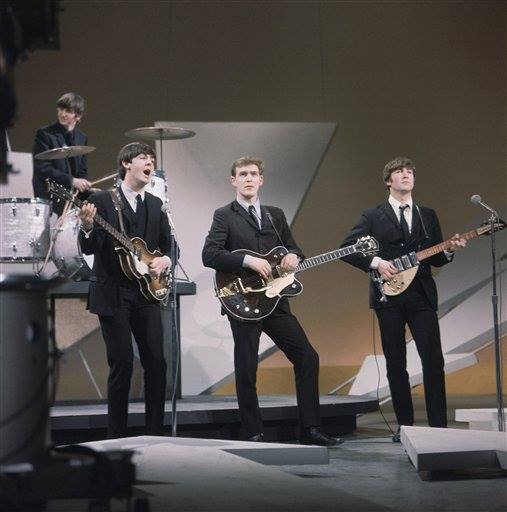

Search Results for: beatles
CBS Portable Prototype In Action, 1962 Belmont Stakes & ’63 Beatles Miami
On May 11, 2021
- Viewseum
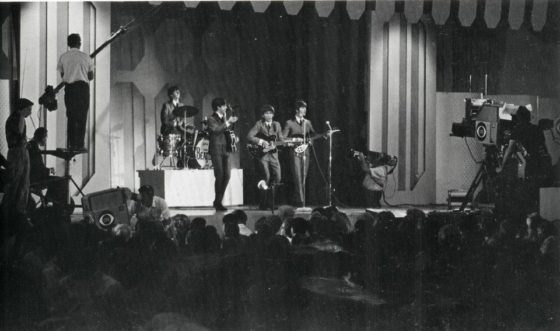
There are two videos here. The first is a great look at the first CBS portable and wireless camera developed in 1961-62 by CBS VP of Technology Dr. Joe Flaherty with help from Ikegami. There were three prototypes with one at CBS O&O KMOX in St. Louis to test for use as an “electronic new gathering” tool, one was at CBS New York for the same and more bench testing and one was assigned to the Florida bound CBS mobile units covering the many manned space missions, at the then, Cape Canaveral.
This footage at the race tracks is a perfect example of the kind of tests they subjected the camera to, and it was also brought on stage for a live demonstration during an Ed Sullivan show, I think, just a few weeks after the Belmont Stakes with Dr. Joe and a couple of the Ikegami engineers introduced during the demo.
With reference to the top photo of The Beatles on stage during the Sullivan’s live Miami show , see the image clarity that this camera makes as he shoots Ringo from a low angle (at :32 and 1:41), just like in the photo. Nice, crisp picture, just like the TK30s are giving us as, I think, they are both using the same 3.5″ image orthicon tube. Thanks to Kevin O’Keefe for the Belmont video.


What Do “Bonanza”, The Beatles And Bozo Have In Common?…
On March 13, 2017
- TV History
What Do “Bonanza”, The Beatles And Bozo Have In Common?
Aside from the letter “B”, the amazing Alan Livingston…that’s what!
If you don’t know who he is, you are not alone, but he – alone – touched the lives of literally all of America’s children, teens and adults in some very important and, above all, entertaining ways.
At Capitol Records, Alan Livingston created the character of Bozo The Clown, revived the carrier of Frank Sinatra, signed The Beatles and The Beach Boys, and…as an NBC Programming executive, hired David Dortort to write the pilot episode of “Bonanza”.
While growing up, Alan took saxophone and clarinet lessons, and his brother, Jay Livingston studied piano. Jay’s writing credits include “Buttons and Bows,” “Mona Lisa”, “Silver Bells”, “Tammy” and “Que Sera, Sera” and more. These, and a surprise that will come below, were co written with his wring partner Ray Evans.
While at the University of Pennsylvania, Livingston and his brother paid expenses by forming an orchestra that played at fraternity dances and school events.
After serving in the Army as a second lieutenant during World War II, Livingston made his way to the west coast where he finally convinced Capitol Records to give him a job. In 1946 Alan was hired to launch a series of storytelling records with illustrated read-along books for children. He called the new concept a “record-reader.”
After writing “Bozo at the Circus,” Livingston worked with an artist to create the clown narrator – a composite design of Livingston’s based on various clown pictures – and he hired former circus clown and cartoon voice-over artist Pinto Colvig to supply Bozo’s voice. The Bozo music was produced by Billy May and Bozo was a big hit, with the series reportedly selling more than 8 million copies over the next several years and spawning Bozo merchandise and Bozo-hosted TV shows. The first of which starred Colvig on KTTV in Los Angeles. By the way, Capitol later sold the Bozo rights to Larry Harmon, who once claimed to have created Bozo, but he eventually set the record straight by crediting Livingston.
Other Livingston-written and produced children’s recordings that allowed Capitol to dominate the children’s record market followed, featuring Woody Woodpecker and various Disney and Warner Bros. cartoon characters.
The next major phase of Alan Livingston’s success came with his
a promotion to vice-president of Capitol. He went from overseeing children’s records to working with adult artists such as Nat King Cole, which yields yet another surprise! “Mona Lisa”.
His songwriting brother Jay had written a song Alan felt was a hit, and very will suited for Cole, but Nat did not care for it. Alan was careful not to make a big deal over it, but kept suggesting and eventually Cole agreed to cut is as a B side of a song Nat thought would be a hit. DJ’s liked the B side better, and before you knew it, the song was Number One, and held there for eight weeks.
Not long after that, Livingston got call from Sammy Weisbourg, who was president of the William Morris Agency. They had taken on a star who’s career was at an all-time low, and were looking for a “fellow gambler” that thought there could be a grand revival.
Weisbourg asked whether Livingston would consider signing Frank Sinatra to a new recording deal and Livingston said yes!
Livingston believed Sinatra was a great singer and, if given the proper material and appropriate instrumental backing, he could be on top again, which lead to a sort of “shotgun marriage”.
Sinatra reluctantly agreed to try a session with Riddle on April 30, 1953. That session produced the classic “I’ve Got The World On A String.” Another session yielded “Young-At-Heart,” which put Frank Sinatra’s comeback in high gear in the spring of 1954.
Livingston left Capitol after a great 10 year run there to become the head of programming for NBC’s west coast Programming Department. That was 1956 and aside from working with Milton Berle, the newly “single” Dean Martin, Dinah Shore and Jimmy Durante, he Tom Sarnoff gave the go ahead to David Dortort’s idea that became NBC’s biggest hit of the ’50s and ’60s…”Bonanza”.
At this link, in an Archive Of American Television interview, Jay Livingston and writing partner Ray Evans talk about Alan and how they came to write the historic theme song for “Bonanza”. https://youtu.be/KiUBFXi81jI?t=19m38s
In 1961, Capitol asked Livingston to come back, and boy did he ever…and brought Capitol with him!
The Beatles’ records were being released in the United Kingdom by EMI, which was Capitol’s major stockholder, which in turn gave Capitol the right of first refusal on all EMI acts for distribution in America. Capitol’s Dave Dexter who reviewed all these artists kept rejecting them, even the Beatles’ early hits, as unsuitable for the American market.
In 1963, Livingston received a call from the Beatles’ manager, Brian Epstein, from London wanting to know why there was no interest in the group. When Livingston said he hadn’t even heard the Beatles sing, Epstein told him to listen to one of their records and call him back.
Livingston did, and the Beatles signed with Capitol, which agreed on a $40,000 budget to promote their first single. In February 1964, the Beatles made their first appearance on “The Ed Sullivan Show,” and Beatlemania in America was in full swing.
He also played roll in signing The Beach Boys, The Steve Miller Band and more.
Livingston, who was married for several years to actress Betty Hutton, left Capitol again in 1968 and formed his own company, Mediarts, which was involved in movies, records and music publishing. Lightning struck again after Alan signed Don McLean and released the smash hit, “American Pie”.
He sold Mediarts to United Artists and joined 20th Century Fox as president of the corporation’s Entertainment Group.
Now THAT is a brilliant carrier! Gone but not forgotten…Alan W. Livingston left us March 13, 2009. Enjoy and share! -Bobby Ellerbee
In the photo, we see Livingston presenting The Beatles with their first, of many, gold records from Capitol.


February 8, 1964…The Beatles & Ed Sullivan Prepare To Make History
On February 8, 2017
- TV History
February 8, 1964…The Beatles & Ed Sullivan Prepare To Make History
On this date in 1964, The Beatles had their first rehearsal for “The Ed Sullivan Show” at CBS Studio 50 in New York. All prior highs in television ratings and record sales was about to explode.
Many still haven’t realized that The Beatles third appearance on “The Ed Sullivan Show” on February, 23 1964 was taped the afternoon of their first live appearance on February 9th. This time table is a great help in understanding the sequence of events that began on this day in 1964.
Some may wonder how the Saturday rehearsal was possible since “The Jackie Gleason Show” was also done at Studio 50 on Saturdays, and the answer may surprise you. Beginning around 1961, Gleason began taping the show on Thursday nights, but it was live-to-tape with no edits, which kept the show looking as live as it had since it’s start in 1952. Enjoy and share! -Bobby Ellerbee
 Above is one of the world’s most unique selfies…Sullivan Assistant Director John Moffit (without his glasses) at Ringo’s black oyster pearl Ludwig drums, just after the Saturday morning rehearsal. The next two photos are from the two Sunday rehearsals and the tall man with the glasses is Moffit and the shorter bald man is Director Tim Kiley.
Above is one of the world’s most unique selfies…Sullivan Assistant Director John Moffit (without his glasses) at Ringo’s black oyster pearl Ludwig drums, just after the Saturday morning rehearsal. The next two photos are from the two Sunday rehearsals and the tall man with the glasses is Moffit and the shorter bald man is Director Tim Kiley.
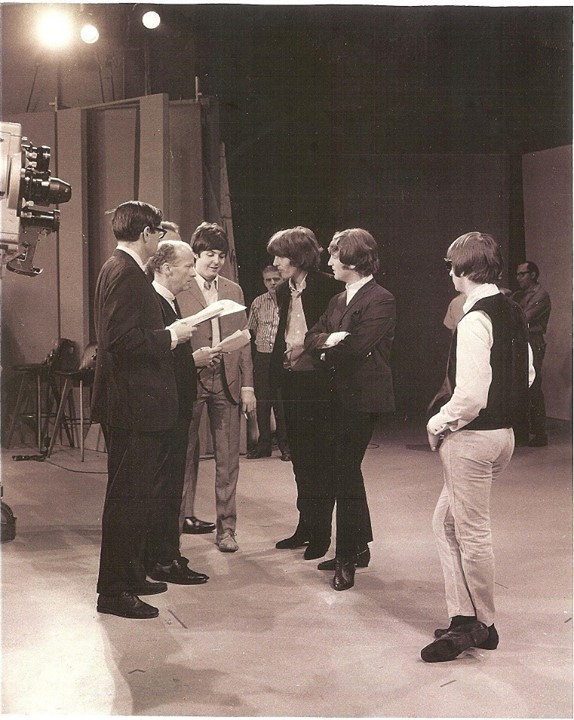
Where The Ed Sullivan “Beatles” Cameras Finally Wound Up…
On September 28, 2016
- TV History
Boy, do I wish I could have one owned one of these three Marconi Mark IV cameras from WCNY-TV!
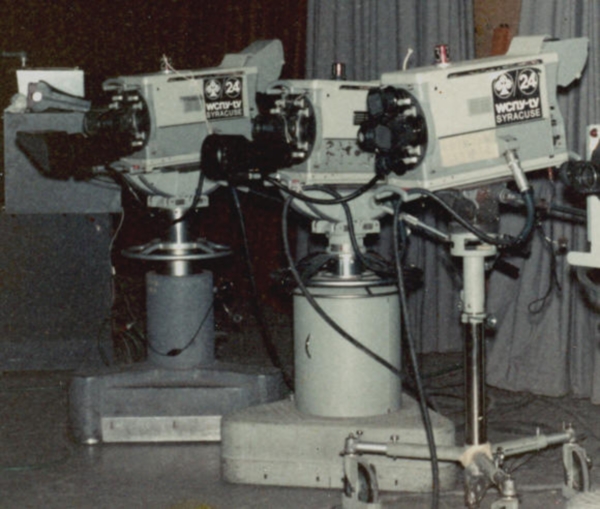
These three Mark IV cameras are very rare, and have a very interesting history. Here are a few shots of these historic cameras in action at WCNY, a PBS affiliate in Syracuse, NY circa 1969.
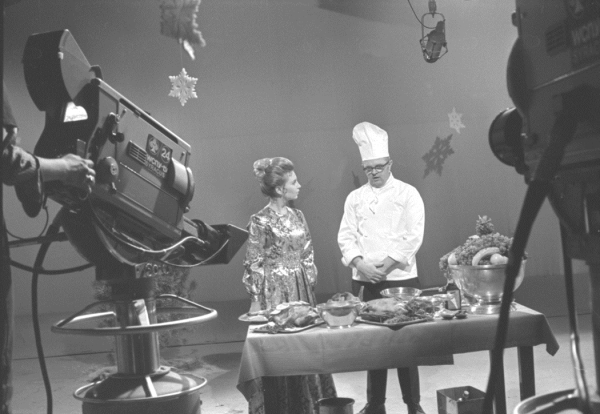
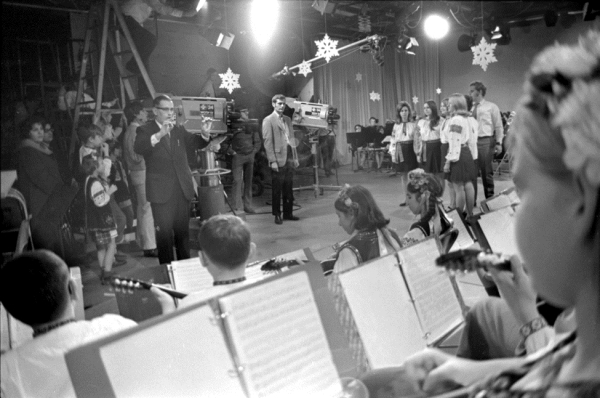
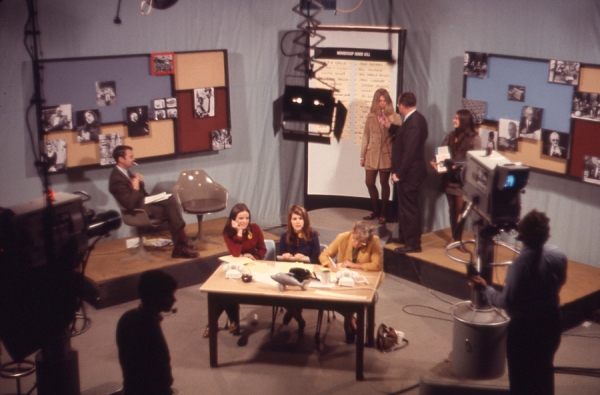
Believe it or not, these are the same cameras that first showed 73 million Americans The Beatles on The Ed Sullivan Show at 8 pm on February 9, 1964! And that’s just one of the thousands of legendary names whose images they captured.
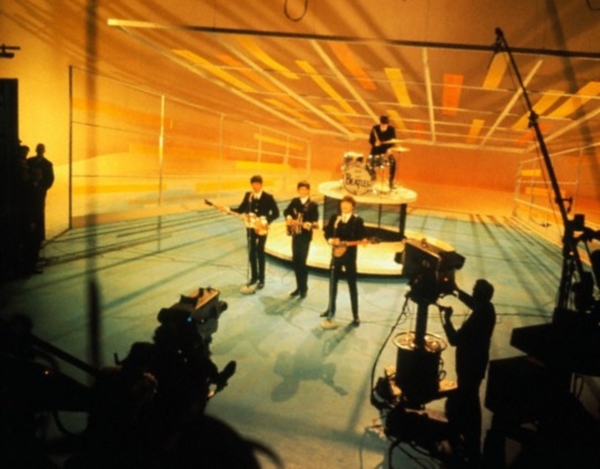
Jackie Gleason also used these cameras in Studio 50, as you’ll see below. I don’t know how many Marconi cameras were used in the theater, but when RCA cameras were in use there, there were always at least five TK10s or TK11s – four on stage and one at audience level. I’m guessing there were at least four, maybe six, of the Marconis there.
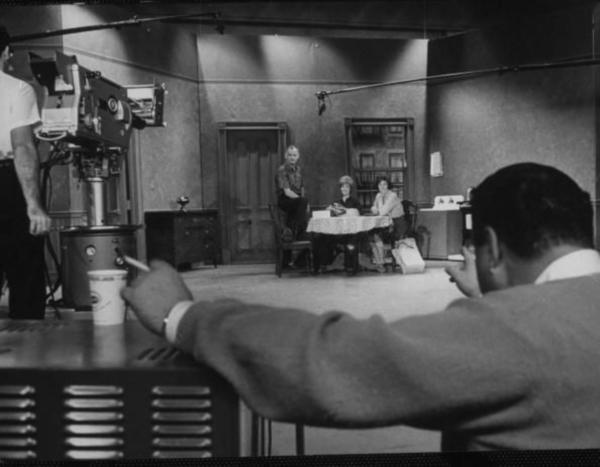
These three cameras were donated to WCNY by CBS after Studio 50, also known as The Ed Sullivan Theater, was temporarily closed to prepare for color telecasting. The show moved to Television City in Hollywood for six weeks while the Norelco PC60s and new lighting were installed. The first colorcast from Studio 50 happened on my 15th birthday, Halloween night, 1965.
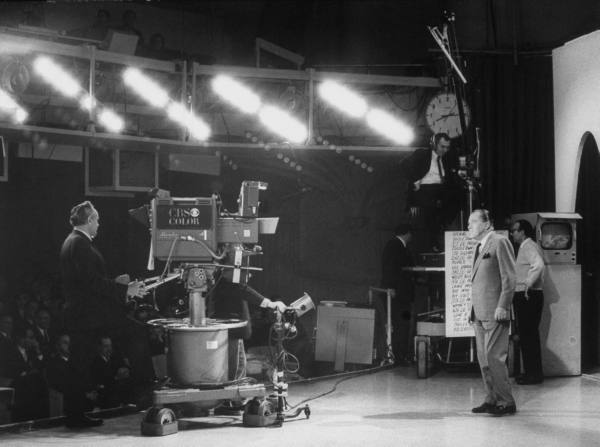
CBS was pretty consistent in donating its old equipment through the years. A lot of it wound up at colleges, educational stations and churches, including the Catholic Broadcast Center run by the Brooklyn archdiocese. That’s where my TD-1 pedestal was rescued from, thanks to “Cardinal” Paul Beck in Boston.
I have quite a soft spot for the Sullivan show and all things associated with it. I’d kill to have owned one of these cameras and would love to know if anyone has any idea where the WCNY Marconis wound up. I have been in contact with the station, but they have no recall. I am fortunate to have one artifact from the Ed Sullivan Theater though, and thank John Smith for giving me the backstage announce microphone he rescued during the Reeves Teletape years in the theater.
The “Beatles” Cameras
On June 27, 2016
Boy, do I wish I could have one owned one of these three Marconi Mark IV cameras from WCNY-TV!

Why? What’s so special about them? Well, aside from the fact that Mark IV cameras are very rare, these three cameras have a very interesting history. In the Camera section, where these cameras are also shown, I gave a clue: “Studio 50.” Can you guess?
Before you scroll down for the answer, here are three more photos of these historic cameras in action at WCNY, a PBS affiliate in Syracuse, NY circa 1969.



Read this before you see the images below!
Did the “Studio 50” clue ring a bell?
Here is another clue…”toast of the town.”
Got it yet?
Well, believe it or not, these are the same cameras that first showed 73 million Americans The Beatles on The Ed Sullivan Show at 8 pm on February 9, 1964! And that’s just one of the thousands of legendary names whose images they captured.

Jackie Gleason also used these cameras in Studio 50, as you’ll see below. I don’t know how many Marconi cameras were used in the theater, but when RCA cameras were in use there, there were always at least five TK10s or TK11s – four on stage and one at audience level. I’m guessing there were at least four, maybe six, of the Marconis there.

These three cameras were donated to WCNY by CBS after Studio 50, also known as The Ed Sullivan Theater, was temporarily closed to prepare for color telecasting. The show moved to Television City in Hollywood for six weeks while the Norelco PC60s and new lighting were installed. The first colorcast from Studio 50 happened on my 15th birthday, Halloween night, 1965.

CBS was pretty consistent in donating its old equipment through the years. A lot of it wound up at colleges, educational stations and churches, including the Catholic Broadcast Center run by the Brooklyn archdiocese. That’s where my TD-1 pedestal was rescued from, thanks to “Cardinal” Paul Beck in Boston.
I have quite a soft spot for the Sullivan show and all things associated with it. I’d kill to have owned one of these cameras and would love to know if anyone has any idea where the WCNY Marconis wound up. I have been in contact with the station, but they have no recall. I am fortunate to have one artifact from the Ed Sullivan Theater though, and thank John Smith for giving me the backstage announce microphone he rescued during the Reeves Teletape years in the theater.
I also have a Norelco PC 60 from CBS Studio 52, which at one time was linked by a passageway to Studio 50, but during the Letterman renovation that was bricked up. Wonder if my Studio 52 camera ever worked next door on Sullivan? I’m pretty sure it was used on Captain Kangaroo, which originated from CBS 52 in the late ’60s.
By the way, after Studio 52 was closed and sold by CBS, it became the infamous New York nightclub Studio 54…the “54” comes from its location on 54th Street. No longer a disco, it’s become a playhouse again.
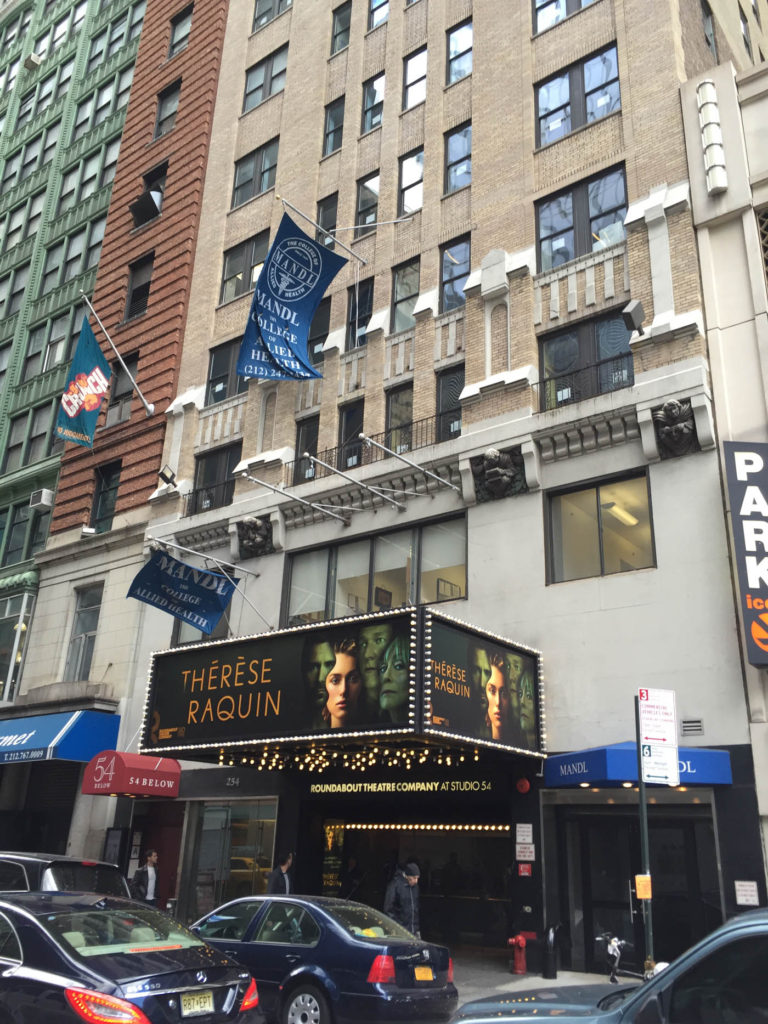
TeleTales #67…A HUGE Beatles SURPRISE!
On February 9, 2015
- TV History
TeleTales #67…A HUGE Beatles SURPRISE!
CBS sent one of their prototype hand held video cameras from Cape Kennedy to Miami to get shots for the February 16, 1964 Beatles appearance on Ed Sullivan.
The man responsible for their creation, Dr. Joe Flaherty, who’s still Senior VP of Technology at CBS, told me a few years back that CBS had teamed up with Ikegami to come up with these cameras.
Their effort had started just the year before in 1963 and this is one of three prototypes Ikegami sent to CBS for use on space mission coverage.
This is the first time one of these cameras was used on anything other than space shots. This photo was taken at the morning sound check which was followed by a dress rehearsal and finally that night’s show.
By late 1964, I think about a dozen had been built and sent out for field tests. Two were sent to CBS O&Os KMOX in St. Louis, two to WBBM in Chicago, two to KNXT in LA, three to WCBS and three were on the CBS mobile units assigned to Cape Kennedy.
Unlike the RCA/NBC portables, I think this has an Image Orthicon tube and not a Vidicon. Enjoy and share! -Bobby Ellerbee
February 9,1964…The Beatles Debuted On Ed Sullivan
On February 9, 2015
- TV History
From last year’s big 50th Anniversary coverage, here is my story on how to tell which scenes are from which shows, which were all taped the same day. Enjoy and share! -Bobby Ellerbee
Beatles 50th Sullivan Anniversary Count Down…15 Days
Today, A Primer In: How to tell which performance is which.
With the anniversary approaching, you’ll see a lot of photos and clips and with this guide, you can tell which performance is which. The Beatles first appeared on Ed Sullivan these three consecutive Sunday nights…February 9, 16 and 23 1964. The February 16th show was done live from Miami, but all four of their other performances were done at CBS Studio 50 on February 9, with the first performances of the day taped for air on the 23rd. The Beatles appeared twice in each show and each time, the song set and stage set was different. From left to right, here are the Studio 50 stage sets in order of air dates. The first live performance set featured big arrows and the second live performance set featured hanging stripes. The first appearance of the taped February 23 show was the only use of a flat wall set with a wedge facade, which was widely used on many Sullivan shows and matched his hosting corner backdrop. The final set of the February 23 show featured the free standing art nouveau columns. Now you know!
What Do ‘Bonanza’, The Beatles And Bozo Have In Common?
On August 8, 2014
- TV History
What Do ‘Bonanza’, The Beatles And Bozo Have In Common?
The amazing Alan Livingston…that’s what!
Livingston was best-known for his years as president of Capitol Records during the 1960s, when he signed The Beatles, but he also created Bozo The Clown and as an NBC executive, was responsible for ‘Bonanza’ coming to the screen.
As Capitol’s president, he signed artists like The Beach Boys, Steve Miller and The Band. His most famous signing, however, took longer than might be expected.
Livingston first heard about the Beatles in 1963 when he read about the group in the English music press. The Beatles’ records were being released in the United Kingdom by EMI. And because EMI was Capitol’s major stockholder, Capitol had the right of first refusal on the Beatles in America. But Capitol rejected the Beatles’ early hit singles as unsuitable for the American market.
Livingston finally received a call from the Beatles’ manager, Brian Epstein, from London wanting to know why there was no interest in the group. When Livingston said he hadn’t even heard the Beatles sing, Epstein told him to listen to one of their records and call him back.
Livingston did, and the Beatles signed with Capitol, which agreed on a $40,000 budget to promote their first single. In February 1964, the Beatles made their first appearance on “The Ed Sullivan Show,” and Beatlemania in America was in full swing.
While growing up, he took saxophone and clarinet lessons, and his brother, Jay, studied piano. Jay later teamed with fellow songwriter Ray Evans, and they shared Oscars for writing “Buttons and Bows,” “Mona Lisa” and “Que Sera, Sera.” Jay Livingston died in 2001.
While at the University of Pennsylvania, Livingston and his brother paid expenses by forming an orchestra that played at fraternity dances and school events. After serving in the Army as a second lieutenant during World War II, Livingston was hired by Capitol Records in Hollywood in 1946 as a writer and producer of storytelling record albums with illustrated read-along books for children.
He called the new concept a “record-reader.”
After writing “Bozo at the Circus,” Livingston worked with an artist to create the clown narrator — a composite design of Livingston’s based on various clown pictures — and he hired former clown and cartoon voice-over artist Pinto Colvig to supply Bozo’s voice.
“Bozo at the Circus,” with music produced by Billy May, was a big hit, with the series reportedly selling more than 8 million copies over the next several years and spawning Bozo merchandise and Bozo-hosted TV shows.
Other Livingston-written and produced children’s recordings followed, featuring Woody Woodpecker and various Disney and Warner Bros. cartoon characters.
In the early ’50s, after becoming vice president in charge of creative operations at Capitol Records, Livingston signed Frank Sinatra, then at a low point in his career, and teamed him up with arranger Nelson Riddle — a pairing that launched Sinatra’s comeback on the charts.
Livingston, who was married for several years to actress Betty Hutton, left Capitol in the late ’50s. He became vice president of NBC network television programming, during which he supervised the pilot for the western series “Bonanza.”
Livingston returned to Capitol Records as president in the early ’60s and became chairman of the board before leaving again in 1968. He later formed his own company, Mediarts, which was involved in movies, records and music publishing.
From 1976 to 1980, he was group president for 20th Century Fox Film Corp.’s television production, records, music and film processing operations.
He then became president of Atalanta Investment Co., a position he resigned in 1987. He also wrote a novel, “Ronnie Finkelhoff, Superstar.”
Now THAT’s one hell of a carrier! Gone but not forgotten…Alan W. Livingston left us March 13, 2009. Thanks to Glenn Mack for recommending some research into Mr. Livingston. Enjoy and share!
In the photo, we see Livingston presenting The Beatles with their first, of many, gold records from Capitol.
A Meeting Of The Minds…The Directors And The Beatles
On February 23, 2014
- TV History
A Meeting Of The Minds…The Directors And The Beatles
The photo above was shot after the Saturday morning rehearsal on February 8, 1964…the more relaxed day of the weekend. In one of the world’s most unique photos, we find assistant director John Moffit posed behind Ringo’s black oyster pearl Ludwig drums (without his glasses). In the center we see Sullivan director Tim Kiley writing and behind him (with glasses) is assistant director John Moffit with Paul and Ringo. On the bottom, John Moffit and Tim Kiley with the whole band on Sunday morning.
50 Years Ago Tonight! The Beatles, live on ‘Ed Sullivan’ from Miami
On February 16, 2014
- TV History
50 Years Ago Tonight!
The Beatles, live on ‘Ed Sullivan’ from The Deuville Hotel in Miami Beach. Thanks to Gay Linvill, here is a brand new photo…one I had never seen until today. This is the first time ever that the CBS/Ikegami hand held prototype ENG camera had been used on an entertainment show. Notice the CBS logos are on pieces of cardboard attached to the side of the cameras…it is covering the large and unique WTVJ camera art. On the camera on the left, you can see the WTVJ call letters on the viewfinder through the paper covering it.
Beatles 50th Sullivan Anniversary Count Down…1 Day
On February 8, 2014
- TV History
Beatles 50th Sullivan Anniversary Count Down…1 Day
Tomorrow, we’ll see pictures from the Sunday afternoon press gaggle, but today we’ll look at the Saturday afternoon press gathering. There had been a rehearsal that morning that had stand ins for George who was ill at the Plaza Hotel, but by late afternoon, he was well enough to help tape promos for the up coming shows and for photos. Notice that the crane mounted camera is up behind them as one promo background may have included the bank of photographers. If you look closely at the far right photo, you notice that all of the press have removed their flash attachments. Flash cameras and Image Orthicon television cameras do not get along well and multiple flashes into that Marconi Mark IV would have fried that $5000 IO tube.


The Beatles’ Debut on ‘Ed Sullivan’
On February 8, 2014
- TV History
Hot Off The Press…New York Times
This week, I had the pleasure of meeting and comparing notes with reporter James Barron, who’s article in today’s New York Times appears at this link. Like me, he’s been doing a lot of deep digging through fifty year old details to uncover some of the people and circumstances that surrounded one of America’s most memorable and transformative Sunday nights…The Beatles first appearance on ‘The Ed Sullivan Show’. Enjoy!
The Beatles’ Debut on ‘Ed Sullivan’
Fifty years later, audience members who were present at the birth of Beatlemania remember the electric atmosphere and the screaming.
Beatles 50th Sullivan Anniversary Count Down…2 Days
On February 7, 2014
- TV History
Beatles 50th Sullivan Anniversary Count Down…2 Days
Today, the sound problems. Notice anything missing in any of the Beatles stage photos either in New York or Miami? No? How about the guitar amplifiers…not a single one anywhere. As mentioned here before, “the sound” was a big problem for all three shows, and most of the problems were caused by the hidden amps. There are three areas of concern that intermingled to cause these problems…the band’s ability to hear their music and vocals, the audience’s ability to hear and the audio mix fed along with the pictures on the broadcasts. There was a concerted effort to make the sets really pop on TV and the set designer wanted to keep them clean by hiding the amps, but that meant putting them behind the scrim and miking them for air which would be fine for the broadcast mix, but the stage and house mix would suffer. I’ve been told that the house PA system at the time was not very good. It was quite adequate for audiences to hear dialog from actors, but it was not meant for music. Even Elvis had amps on stage when he performed there in the late 50s and as far as I know, this was the first attempt to hide the amps. The Beatles performances were totally live and in rehearsals, even without the audiences, it took a while to tweak the audio. But then, when the audiences came in, the screaming was so overwhelming that it drowned out that balance so another round of tweaking started. The audience was so loud, the cameramen could not hear anything in their headsets. The band had a #1 record and the performance had to match the sound on the radio. Brian Epstine and John Lennon were so flustered by the sound problems in the theater, even at the closed rehearsals, that he and the band went to the control room a couple of times to hear the playback of the rehearsal tapes just to make sure the broadcast audio was right. It did not help that the audio man’s grease pencil marks from the Sunday morning closed rehearsal had been erased prior to the 2:30 dress rehearsal. That lasted almost till the 4:30 taping of the performances to be inserted into the February 23 show.
50 years later — A fan recalls watching the Beatles’ American debut
On February 6, 2014
- TV History
50,000 Requests For 728 Seats…
Andrea Tibbits got one of them. Here’s Anthony Mason’s story on her night with The Beatles from last night’s CBS Evening News.
50 years later — A fan recalls watching the Beatles’ American debut
The then 13-year-old scored a ticket to famed group’s appearance on The Ed Sullivan Show; and as the cameras closed in, there she was screaming
Beatles 50th Sullivan Anniversary Count Down…3 Days
On February 6, 2014
- TV History
Beatles 50th Sullivan Anniversary Count Down…3 Days
This extremely rare photo goes a long way in clearing up some long lost details of the day’s rehearsals on February 9, 1964. This photo was taken at the 2:30 dress rehearsal at Studio 50 for that night’s live show, which was to be followed at 4:30 by the taping of two song sets for insertion into the February 23 show…the third and last Beatles appearance of this visit. With Ringo’s coat off, this photo helps prove that the 2:30 dress was a long and drawn out process. Candice Cushing, who was there, has told me that there were a lot of starts and stops because the sound was just not right. I’d mentioned before that the band had rehearsed that morning, but the story is that someone had erased the grease pencil marks on the audio board before dress rehearsal. The band went into the control room that morning to listen to play backs of the sound check and may have done that again in the 2:30 dress. No one had ever done that before but they did! A full dress rehearsal would have gone till 3:30 with an hour between that and the taping session, but I feel pretty sure that the 2:30 dress lasted until at least 4 or 4:15. The 4:30 taping should have taken half an hour and end by 5 when the day’s first audience would exit. The band left for the hotel after the taping and returned at 7 for the live show at 8. Tomorrow, we’ll discuss the sound problems but if you look at all the photos of the band’s Sullivan appearances, even in Florida, you’ll notice something missing that was the root of the problem.


Mitzi Gaynor…Headline Act For Beatles Miami Show Tells All
On February 6, 2014
- TV History
Mitzi Gaynor…Headline Act For Beatles Miami Show Tells All
This is a wonderful five minute clip of Mitzi talking about her appearance on ‘The Ed Sullivan Show’ on February 16 which would be the Beatles second time on the show. In an earlier post, I mentioned the heat in the Deauville Hotel’s ballroom and how everyone was gleaming with sweat. What I did not tell you was the story Mitzi alludes to here…about her “glistening cleavage”. Sullivan production secretary Barbra Forster was there and told me this story. Even though they were in Miami, so was a CBS censor! The man from the dreaded Program Practices saw the rehearsal and notice Mitzi was sweating as she danced and it was only after seeing the sweat drip into her cleavage that he became concerned that she was showing too much. After a lot of cringing and arguing, more powder was added and a small scarf was tucked in behind the top of her dress to cover the offending extra inch of skin. Now you’ll understand her comments about the catholic church. Thanks to Glenn Mack for the link.
http://www.youtube.com/watch?v=pI-8YxFNArM&feature=youtu.be
See the full interview at http://www.emmytvlegends.org/interviews/people/mitzi-gaynor
Beatles 50th Sullivan Anniversary Count Down…4 Days
On February 5, 2014
- TV History
Beatles 50th Sullivan Anniversary Count Down…4 Days
Notice the lady in the glasses behind George Harrison…that is Barbara Forster. At the time, she was Barbra Smith, secretary to Ed’s son in law, and producer Bob Precht. Here’s an interesting story she told me Sunday. Only two production secretaries traveled to Miami for the second Beatles appearance and the work was non stop…she was lucky to get four hours of sleep, but maybe the second part of this story makes up for that. When musical artist appeared on the show, they always had to supply a lead sheet of music with lyrics to aid the director in taking shots at the right time. The Beatles did not have any so, as Barbra took notes in short hand, Paul sang/talked the lyrics of all seven songs to her and sometimes John sang along. They were in living room of the band’s suite where John, George and Ringo and they were calling room service for more “tellys” to be brought up for each bedroom. The camera in the photo is an RCA TK30 owned by long time CBS affiliate WTVJ (my old alma mater). The CBS logo is on a large sheet covering the local call letters. Notice that where the focus knob should be, there is a camera 4 placard which is covering the hole. Why? Because WTVJ’s first cameras were Dumont 124B models with the focus control built into the right pan handle. When they got the TK30s, the cameramen had liked the old way so much that they bought an RCA TK41 pan handle for each camera which attached to the bottom, right of the TK30 camera body.


Sullivan/Beatles Schedule, Shows 1, 2 and 3
On February 4, 2014
- TV History
Sullivan/Beatles Schedule, Shows 1, 2 and 3
I’ve had this for a few weeks, but until now, I could not vouch for it’s accuracy. The problem has always been the Saturday, February 8 rehearsal for camera blocking. I’ll go into detail in another of today’s posts on why I resisted believing in the Saturday rehearsal and it has to do with Jackie Gleason. In the mean time, take a look. When you look at the song lists, remember they were split up into performances in the first half hour and the second half hour of each show.
Beatles 50th Sullivan Anniversary Count Down…6 Days
On February 3, 2014
- TV History
Beatles 50th Sullivan Anniversary Count Down…6 Days
Mayhem in Miami. The photo on the left was shot during the dress rehearsal and is a mirror reflecting the Beatles over the head of the audience of 2,500. One camera is shooting the crowd and one cameraman with his back to us is shooting the band. There were 6 TK30s there for the Miami show, but the only camera on stage was the CBS/Ikegami hand held we saw last week. On the right is a shot of The Deauville Hotel on Saturday, the day before the show and the crowds are already huge. Yesterday Betty Forster who was a Sullivan production secretary told me how hard it was for staff to get into Studio 50 on Saturday and Sunday the week before in New York, but the Miami mob scene was just incredible. The fire department had a hook and ladder at the hotel because girls were literally climbing the walls of the hotel to get inside. Barbara said the one work that would best describe the Miami show is “overwhelming”. Not only for the staff, but so was everything else, including the hotel’s power, air conditioning and security force. Generators had to be brought in to run the production truck as the hotel power source became unstable. Adding all the stage light heat to an unusually hot day and two audiences of 2,500 each, the air conditioning was straining and this was a problem. Mitzi Gaynor who was also on the show was shiny with perspiration in rehearsals and make up people were constantly adding powder to all the entertainers. The owner of the hotel wrote in a telegram to Sullivan that the security force was double the size of the one on hand for a visit from President Kennedy the year before, but as we’ll see later in this week, that still wasn’t enough. At the New York show, the camera crew had learned the hard way to do exactly what they did in rehearsals because you could not hear anything in the headsets because of all the screaming.
Beatles 50th Sullivan Anniversary Count Down…7 Days
On February 2, 2014
- TV History
Beatles 50th Sullivan Anniversary Count Down…7 Days
The more I dig into the details, the more interesting this story becomes. Most of us never knew George Harrison was very sick with the flu and up till the last minute, it was 50/50 on whether he would be able to perform. As I had posted before, Beatles road manager Neil Aspinall (left photo) stood in for Harrison at the short Saturday camera rehearsal (Feb 8, 1:30) and again at the 9:30 AM rehearsal, BUT…there was a “stand in” for “the stand in”! During the Sunday morning rehearsal, manager Brian Epstein rushed Aspinall back to the hotel to deal with a crises. Harrison’s sister, Louise, who’d been taking care of him, couldn’t get past security back into the Plaza Hotel with medicine she had just picked up. It was a mob scene and, the band was in danger of being booted out of the Plaza due the arrival of thousands of teenagers outside. In the center and right photos, we see Sulliavn’s 29 year old Vince Calandra standing in for Aspinall and Harrison. Vince started in the mail room, moved to Q cards and at this point, was an associate producer. He later said in his 14 years with Sullivan, no one had ever asked to go into the control room to see a playback of their rehearsal, but The Beatles did. Years later, Ringo recalled how bad the sound was and how hard they had to work with the audio people to improve the sound they started with. That’s the reason the 2:30 dress rehearsal lasted almost 2 hours and nearly pushed back the 4:30 taping of the February 23 show.